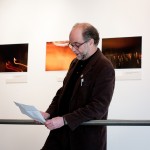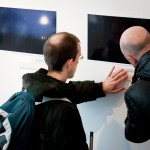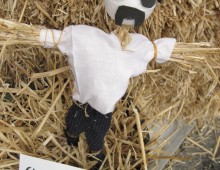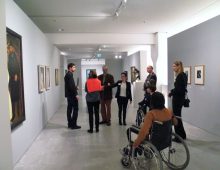Edinburgh | April 2012
In this collaborative exhibition at Coburg House Studios and Gallery, Edinburgh, Morwenna Kearsley and blind photographer Rosita McKenzie present photographic works based on their interpretations of science and art. I worked with Morwenna and Rosita, co-curating the exhibition and developing the catalogue text and audio guide descriptions.
Taken over the winter of 2011/12, Rosita and Mowenna took photographs in response to each other’s practices. The resulting exhibition thus explored their different approaches to the concept and processes of mirroring and reflecting.
Rosita’s photography takes an abstract approach; her digital colour images suggest a subterranean world, deep under the sea, in which fantastic, fluorescent creatures inhabit an otherwise dark environment. However, Rosita hasn’t captured deep sea creatures, but rather sources of light and their distortion often created by a quick movement of the camera. These nocturnal scenes of streetlights, fireworks and even the moon casting their glow upon Edinburgh’s beech suburb of Portobello show a material world rendered abstract, alive and alien. Everyday places that are familiar to us, are distorted to look like documentary images from science or nature.
Morwenna’s work focuses on the traditional idea of recording the human species. Taking inspiration from 19th Century scientists such as Guillaume Duchenne she has produced a series of work that both reflects the aesthetics of that time and explores the relationship between photographic art and science. To achieve this, Mowenna has used a traditional process of analogue black and white printing and the more antiquated process of wet plate collodion. This involves coating a sheet of clear glass with silver nitrate and then exposing it to light to create a negative image directly on the glass. Then, by spraying the back of the glass sheet, Mowenna turns the image into a positive. The wet plate collodian process distorts her imagery, and placed on display alongside Rosita’s photographs, suggests that these beings, whether human or alien, may well originate from the very eerily aquatic surroundings Rosita has depicted.
You can listen to the audioguide description of the exhibition below and you can read the text version here.
Audio clip: Adobe Flash Player (version 9 or above) is required to play this audio clip. Download the latest version here. You also need to have JavaScript enabled in your browser.
Exhibition images below courtesy of David Brehme.
- Morwenna Kearsley, Rosita McKenzie and Kate Martin at the opening of An Alternative

































